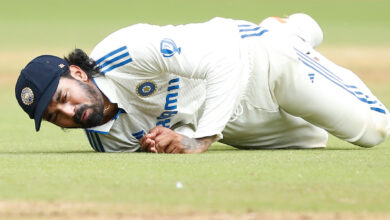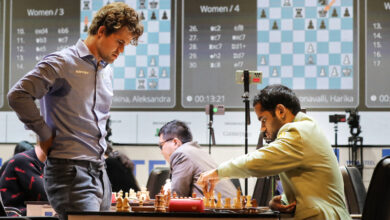India vs Australia 1st T20I: Jasprit Bumrah with the ultimate penultimate over

On his return to T20 cricket after his Test exploits Down Under, Jasprit Bumrah did what he habitually does in the shortest format — sling yorkers, detonate stumps, threaten faces, batter toes, vary his pace and lengths, affect the yorker-bouncer double-bluff. In short, he executed a perfect textbook T20 act, without betraying any break-induced rustiness.
As always, Bumrah expended every ounce of his energy and nous to keep India in the match, first with a terrific spell upfront, ratcheting up the pressure, which resulted in the run-out of Marcus Stoinis, and nailing Australia skipper Aaron Finch in front. His back-bender had harassed Finch all summer, and so it did in Vizag, angling in sharply at pace, Finch beaten by a concoction of pace, angle and late inward movement. But it was his 19th over that had the mind spinning and eyes popping for its furious efficiency. It’s like Bumrah has every nuance for every occasion so forensically formatted in his mind that he just needs to flick a switch, as per the demand of the circumstance. New ball, old ball, first over, last over, dry pitch, flat strip, powerplay, death over — he has a plan in place for every situation, which he modifies, improvises and fine-tunes.
It’s a mix of several variables that makes Jasprit Bumrah so difficult for batsman to read him. Or, in the context of T20 cricket, difficult to hit him. His unique action is one of the storied factors—the hyper-extended elbow and the whip during the release concede an impression that he’s flinging the ball full, which is not always the case. So, it’s incredibly difficult to read him off his hands. Having misjudged the length, the batsman is stripped off precious time to make the redemptive adjustments because he’s furiously quick (in the air and off the pitch). They can’t premeditate or commit to their stroke. As if these aren’t vicious factors enough, he’s a master of playing with lengths, blessed with the ability to change lengths without any noticeable change in action, wrist-position or run-up (for example, some bowlers jump more when they’re bowling bouncers, while some go a trifle side-on for the inswingers). Then kicks in his rich bag of variations. The only new-age weaponry he doesn’t own is perhaps is a knuckle ball. He wouldn’t need one — most bowlers will be content with half his skills — for he is so good at harnessing the rest of his skills. The yorker, is at his beck and call, the slow bouncer, even he has got bored of it, the curve-ball that befuddled Shaun Marsh in Melbourne, well that’s served for occasions (World Cup, maybe). His mischief doesn’t end here — he’s a master manipulator of crease and angle.
So Virat Kohli summoned his gun bowler for the penultimate over. Australia required 16 runs, a largely achievable target in this day, age and format. The temptation could have been to keep him for the last, but then Kohli thought that could have been too late. Asking him to defend four or five runs would have been pointless (though if there is one bowler in the Indian team who can accomplish the impossible, it’s Bumrah).
In the scorer’s shorthand it went thus: 0101WW. It doesn’t capture the visual thrill of watching him — fast bowling, as an art, certainly needs to be watched to be fully appreciated — but it conveys, in plains terms, fragments of what makes him so special. Stingy, wicket-taking, precise, efficient, soaking the exonerating pressure swirling around him, and beyond it all, the ability to make it look routine. And after wreaking all the havoc, he turned around with that bemused what’s-the-fuss-about-me look, and then slunk off into a far-flung outpost on the field.
Not just this over, he was indecipherable throughout the match (several Australians would correct it, an entire summer, they’d chorus). He took three wickets, piled in 18 dots, conceding just three boundaries. He deservedly got a standing ovation, though not the victory that he deserved. Nonetheless, he relived the magical 19th-over, ball by ball, to bcci.tv, a self-psychoanalysis.
18.1: “It was an up-and-down wicket, so it was a little sluggish wicket to play on. To play the big shots was difficult, so I just wanted to bowl a back-of-a-length delivery. He [Peter Handscomb] played across the line. He missed the ball, so it was a dot ball.”
18.2: “I wanted to do the same, but he stepped out, and it went towards square-leg, he took a single. So still, evenly poised.”
18.3: “The strike changed, so Nathan Coulter-Nile was on strike. So just trying to back your strengths, trying to back the ball that I wanted to bowl. I changed the field a little bit and then bowled a back-of-the-length delivery, which also went well, the execution was good on the day. Got another dot ball.”
18.4: “I was just thinking what should I do? Should I change or should I keep on doing the thing which is working? We thought of backing the same thing. So another back-of-length delivery because on these kinds of wickets, people usually feel we’ll go yorker, yorker, yorker, but on up-and-down wickets, length balls are always very effective. Another single.”
18.5: “The last two balls were there, so obviously it is very important to close off the over. I was just talking to the captain: what should I do, what do you [Kohli] think, what do I think. We were just discussing. Peter Handscomb was on strike. I knew he was going to take a chance off this ball, because obviously then it will be easier for them in the last over.
“Just another thing that was going into my head was: why to change things if nothing is going wrong? So I was just trying to back the balls which I had bowled earlier. I knew he was trying to go for the big shot, so till the end, [I] tried to watch him – maybe he is going to step out, [maybe] try to give himself room. So I was just focusing on that. So I bowled a length ball, he tried to step out, it went up in the air, and it went towards Mahi bhai, who is always safe as houses. So we were in a very good position.”
18.6: “There was a little discussion [about] what do I do. Because everybody knew that this is going to be a very important ball, if we close off the over well this will help us to be in a very good position [going] in [to] the last over. So we had some discussions with Virat and Rohit [Sharma], but then we decided to back my strength. We had bowled a lot of length balls, so then we wanted to back my yorker, which I always do. Trying to execute that, and on the given day it was a good execution. So it was a good day in the field. I was very clear on the execution, which I wanted to do. Very happy to be back.”
It’s the beauty of Bumrah, he’s spoilt for variations, yet uncluttered, knows what to unfurl when and against which batsman, but doesn’t overuse his tricks. For instance, he wouldn’t have tried back-of-length deliveries against Glenn Maxwell, gifted as he’s to pick the length of the bowler quite early. But he could have slipped in more slower deliveries, especially the slow bouncer, or the scrambled-seam cutter. Or if he was bowling against tail-enders, he could have flung in more yorkers.
Thus, it’s the flexibility of mind that strikes you first, then comes adaptability and clarity, then the absolute confidence in his abilities, then the mastery of execution, and then that disarming smile. Killer smile, as hapless batsmen would attest. And by the time he hangs up his boots, he would have expanded the boundaries of the bowling manual.







